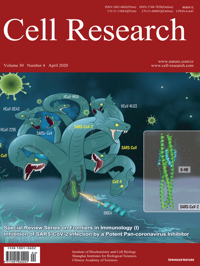
Advanced Search
Submit Manuscript
Advanced Search
Submit Manuscript
Volume 30, No 4, Apr 2020
ISSN: 1001-0602
EISSN: 1748-7838 2018
impact factor 17.848*
(Clarivate Analytics, 2019)
Volume 30 Issue 4, April 2020: 356-359 |
In vitro expansion of human sperm through nuclear transfer
Xiaoyu Merlin Zhang1, Keliang Wu2, Yuxuan Zheng 3,4,5, Han Zhao2, Junpeng Gao 3,4, Zhenzhen Hou2, Meiling Zhang6,Jiaoyang Liao1, Jingye Zhang2, Yuan Gao2, Yuanyuan Li1, Lin Li3,Fuchou Tang 3,4,5, Zi-Jiang Chen2 and Jinsong Li 1,7
1State Key Laboratory of Cell Biology, Shanghai Key Laboratory of Molecular Andrology, Center for Excellence in Molecular Cell Science, Shanghai Institute of Biochemistry and Cell Biology, Chinese Academy of Sciences, University of Chinese Academy of Sciences, 320 Yueyang Road, Shanghai 200031, China; 2Center for Reproductive Medicine, Shandong University, Jinan, Shandong 250001, China; 3Beijing Advanced Innovation Center for Genomics, College of Life Sciences, Peking University, Beijing 100871, China; 4BiomedicalDear Editor,
Mammalian haploid embryonic stem cells (haESCs) represent an ideal tool for genetic analysis due to the presence of only one set of genetic materials. HaESCs fall into two readily distinguishable groups based on their genome origins: parthenogenetic haESCs (PG-haESCs) that are derived from oocyte-originated parthenogenetic embryos and androgenetic haESCs (AG-haESCs) that are produced through sperm nuclear transfer. Both PG- and AG-haESCs are feasible for delineating genome function at cellular level in vitro. Importantly, AG-haESCs can be used as a sperm replacement and applied to deciphering gene function at organismal level when combined with CRISPR-Cas9 technology.1 However, while PG-haESCs have been generated from both rodent and primates,2,3,4,5 AG-haESCs can only be obtained in rodent to date.6,7